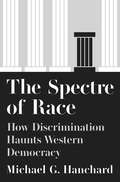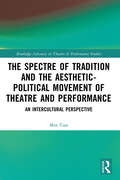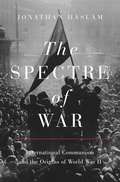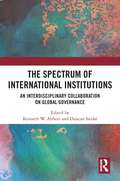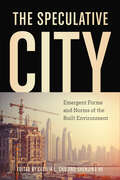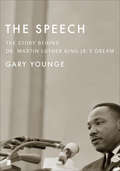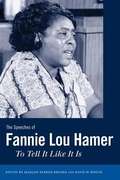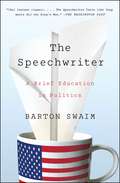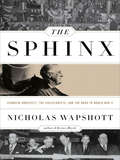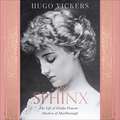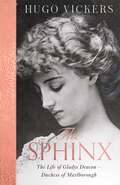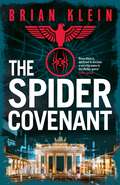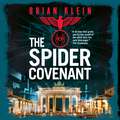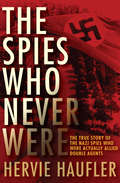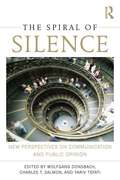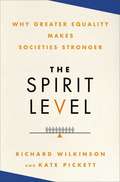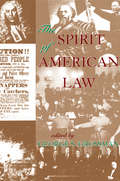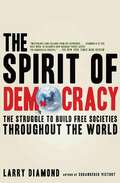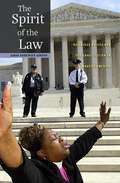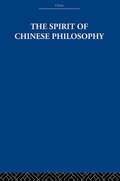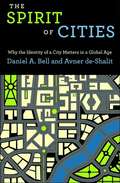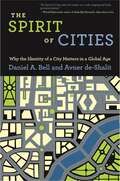- Table View
- List View
The Spectre of Race: How Discrimination Haunts Western Democracy
by Michael HanchardHow racism and discrimination have been central to democracies from the classical period to todayAs right-wing nationalism and authoritarian populism gain momentum across the world, liberals, and even some conservatives, worry that democratic principles are under threat. In The Spectre of Race, Michael Hanchard argues that the current rise in xenophobia and racist rhetoric is nothing new and that exclusionary policies have always been central to democratic practices since their beginnings in classical times. Contending that democracy has never been for all people, Hanchard discusses how marginalization is reinforced in modern politics, and why these contradictions need to be fully examined if the dynamics of democracy are to be truly understood.Hanchard identifies continuities of discriminatory citizenship from classical Athens to the present and looks at how democratic institutions have promoted undemocratic ideas and practices. The longest-standing modern democracies--France, Britain, and the United States—profited from slave labor, empire, and colonialism, much like their Athenian predecessor. Hanchard follows these patterns through the Enlightenment and to the states and political thinkers of the late nineteenth and early twentieth centuries, and he examines how early political scientists, including Woodrow Wilson and his contemporaries, devised what Hanchard has characterized as "racial regimes" to maintain the political and economic privileges of dominant groups at the expense of subordinated ones. Exploring how democracies reconcile political inequality and equality, Hanchard debates the thorny question of the conditions under which democracies have created and maintained barriers to political membership.Showing the ways that race, gender, nationality, and other criteria have determined a person's status in political life, The Spectre ofRace offers important historical context for how democracy generates political difference and inequality.
The Spectre of Tradition and the Aesthetic-Political Movement of Theatre and Performance: An Intercultural Perspective (Routledge Advances in Theatre & Performance Studies)
by Min TianThis book interrogates anew the phenomenon of tradition in a dialogical debate with a host of Western thinkers and critical minds. In contrast to the predominantly Western approaches, which look at traditions (Western and non-Western) from a predominantly (Western) modernist perspective, this book interrogates, from an intercultural perspective, the transnational and transcultural consecration, translation, (re)invention, and displacement of traditions (theatrical and cultural) in the aesthetic-political movement of twentieth-century theatre and performance, as exemplified in the case studies of this book. It looks at the question of traditions and modernities at the centre of this aesthetic-political space, as modernities interculturally evoke and are haunted by traditions, and as traditions are interculturally refracted, reconstituted, refunctioned, and reinvented. It also looks at the applicability of its intercultural perspective on tradition to the historical avant-garde in general, postmodern, postcolonial, and postdramatic theatre and performance and to the twentieth-century "classical" intercultural theatre and the twenty-first-century "new interculturalisms" in theatre and performance. To conclude, it looks at the future of tradition in the ecology of our globalized theatrum mundi and considers two important interrelated concepts, future tradition and intercultural tradition. This book will be of great interest to students and scholars in performance studies.
The Spectre of War: International Communism and the Origins of World War II (Princeton Studies in International History and Politics #184)
by Jonathan HaslamA bold new history showing that the fear of Communism was a major factor in the outbreak of World War IIThe Spectre of War looks at a subject we thought we knew—the roots of the Second World War—and upends our assumptions with a masterful new interpretation. Looking beyond traditional explanations based on diplomatic failures or military might, Jonathan Haslam explores the neglected thread connecting them all: the fear of Communism prevalent across continents during the interwar period. Marshalling an array of archival sources, including records from the Communist International, Haslam transforms our understanding of the deep-seated origins of World War II, its conflicts, and its legacy.Haslam offers a panoramic view of Europe and northeast Asia during the 1920s and 1930s, connecting fascism’s emergence with the impact of the 1917 Bolshevik Revolution. World War I had economically destabilized many nations, and the threat of Communist revolt loomed large in the ensuing social unrest. As Moscow supported Communist efforts in France, Spain, China, and beyond, opponents such as the British feared for the stability of their global empire, and viewed fascism as the only force standing between them and the Communist overthrow of the existing order. The appeasement and political misreading of Nazi Germany and fascist Italy that followed held back the spectre of rebellion—only to usher in the later advent of war.Illuminating ideological differences in the decades before World War II, and the continuous role of pre- and postwar Communism, The Spectre of War provides unprecedented context for one of the most momentous calamities of the twentieth century.
The Spectrum of International Institutions: An Interdisciplinary Collaboration on Global Governance
by Duncan Snidal Kenneth W. AbbottThis book collects and integrates Abbott and Snidal’s influential scholarship on indirect global governance, with a new analytical introduction that probes the role of indirect governance techniques in the universe of global governance arrangements. The volume presents the Governance Triangle, a now widely-used figure that demonstrates and helps to assess the proliferation of private and public-private standard-setting organizations, along with new forms of intergovernmental institutions, over recent decades. It then analyzes how intergovernmental organizations, regulatory bodies, and other "global governors" enlist and work through those organizations as intermediaries, so as to govern more effectively and gain knowledge, influence and legitimacy. It demonstrates Abbott’s and Snidal’s groundbreaking concept of orchestration, a mode of indirect governance in which influential governors catalyze, support, and steer intermediary organizations through wholly voluntary relationships. It also considers their more recent innovations in the theory of indirect governance. These include additional modes of governance, such as co-optation, delegation and trusteeship, as well as the pervasive "Governor’s Dilemma" trade-off between a governor’s control of its intermediaries and the intermediaries’ competence. This book will appeal to scholars and students in multiple disciplines, including international relations, global governance, law, and regulatory studies.
The Speculative City: Emergent Forms and Norms of the Built Environment
by Shenjing He Cecilia L. ChuThe Speculative City explores property speculation as a key aspect of financialization and its role in reshaping the contemporary built environment. The book offers a series of case studies that encompass a range of cities whose urban fabrics have undergone significant transformation in recent years. While the forms of these developments shared many similarities, their trajectories and social outcomes were contingent upon existing planning and policy frameworks and the historical roles assumed by the state and the private sector in housing and welfare provision. By paying close attention to the forces and actors involved in property development, this book underscores that the built environment has played an integral part in the shaping of new values and collective aspirations while facilitating the spread of financial logics in urban governance. It also shows that these dynamics represent a larger shift of politics and culture in the ongoing production of urban space and prompts reflections on future trajectories of finance-led property speculation.
The Speech: The Story Behind Dr. Martin Luther King Jr.'s Dream
by Gary YoungeIn this &“slim but powerful book,&” the award-winning journalist shares the dramatic story surrounding MLK&’s most famous speech and its importance today (Boston Globe).On August 28, 1963, Dr. Martin Luther King Jr. led the historic March on Washington for Jobs and Freedom, where he delivered the most iconic speech of the civil rights movement. In The Speech, Gary Younge explains why King&’s &“I Have a Dream&” speech maintains its powerful social relevance by sharing the dramatic story surrounding it. Today, that speech endures as a guiding light in the ongoing struggle for racial equality.Younge roots his work in personal interviews with Clarence Jones, a close friend of Martin Luther King Jr. and his draft speechwriter; with Joan Baez, a singer at the march; and with Angela Davis and other leading civil rights leaders. Younge skillfully captures the spirit of that historic day in Washington and offers a new generation of readers a critical modern analysis of why &“I Have a Dream&” remains America&’s favorite speech. &“Younge&’s meditative retrospection on [the speech&’s] significance reminds us of all the micro-moments of transformation behind the scenes—the thought and preparation, vision and revision—whose currency fed that magnificent lightning bolt in history.&” —Patricia J. Williams, legal scholar and theorist
The Speeches of Fannie Lou Hamer: To Tell It Like It Is
by Fannie Lou Hamer Maegan Parker Brooks Davis W. HouckMost people who have heard of Fannie Lou Hamer (1917-1977) are aware of the impassioned testimony that this Mississippi sharecropper and civil rights activist delivered at the 1964 Democratic National Convention. Far fewer people are familiar with the speeches Hamer delivered at the 1968 and 1972 conventions, to say nothing of addresses she gave closer to home, or with Malcolm X in Harlem, or even at the founding of the National Women's Political Caucus. Until now, dozens of Hamer's speeches have been buried in archival collections and in the basements of movement veterans. After years of combing library archives, government documents, and private collections across the country, Maegan Parker Brooks and Davis W. Houck have selected twenty-one of Hamer's most important speeches and testimonies. As the first volume to exclusively showcase Hamer's talents as an orator, this book includes speeches from the better part of her fifteen-year activist career delivered in response to occasions as distinct as a Vietnam War Moratorium Rally in Berkeley, California, and a summons to testify in a Mississippi courtroom. Brooks and Houck have coupled these heretofore unpublished speeches and testimonies with brief critical descriptions that place Hamer's words in context. The editors also include the last full-length oral history interview Hamer granted, a recent oral history interview Brooks conducted with Hamer's daughter, as well as a bibliography of additional primary and secondary sources. The Speeches of Fannie Lou Hamer demonstrates that there is still much to learn about and from this valiant black freedom movement activist.
The Speechwriter
by Barton SwaimBarton Swaim was struggling to find an academic job--he'd recently received a PhD in English--when he sent his resume to Mark Sanford, the conservative and controversial governor of South Carolina. He thought he could improve the governor's writing and speeches. On the surface, this is the story of Sanford's rise and fall. But it's really an account of what happens when a band of believers attach themselves to an ambitious narcissist. Everyone knows this kind of politician--a charismatic maverick who goes up against the system and its ways, but thinks he doesn't have to live by the rules. Swaim describes what makes people invest in their leaders, how those leaders do provide moments of inspiration, and then how they let them down.The Speechwriter is a funny and candid introduction to the world of politics, where press statements are purposefully nonsensical, grammatical errors are intentional, and better copy means more words. Through his three years in the governor's office, Swaim paints a portrait of a man so principled he'd rather sweat than use state money to pay for air conditioning, so oblivious he'd wear the same stained shirt for two weeks, so egotistical he'd belittle his staffers to make himself feel better, and so self-absorbed he never once apologized for making his administration the laughing stock of the country. In the end, it's also an account of the very human staffers who risk a life in politics out of conviction and learn to survive a broken heart.
The Spending and Absorption of Aid in PRGF Supported Programs
by Jan Kees Martijn Paolo Dudine Markus Berndt Abu ShonchoyA report from the International Monetary Fund.
The Sphinx: Franklin Roosevelt, the Isolationists, and the Road to World War II
by Nicholas WapshottBefore Pearl Harbor, before the Nazi invasion of Poland, America teetered between the desire for isolation and the threat of world war. May 1938. Franklin Delano Roosevelt--recently reelected to a second term as president--sat in the Oval Office and contemplated two possibilities: the rule of fascism overseas, and a third term. With Hitler's reach extending into Austria, and with the atrocities of World War I still fresh in the American memory, Roosevelt faced the question that would prove one of the most defining in American history: whether to once again go to war in Europe. In The Sphinx, Nicholas Wapshott recounts how an ambitious and resilient Roosevelt--nicknamed "the Sphinx" for his cunning, cryptic rapport with the press--devised and doggedly pursued a strategy to sway the American people to abandon isolationism and take up the mantle of the world's most powerful nation. Chief among Roosevelt's antagonists was his friend Joseph P. Kennedy, a stock market magnate and the patriarch of what was to become one of the nation's most storied dynasties. Kennedy's financial, political, and personal interests aligned him with a war-weary American public, and he counted among his isolationist allies no less than Walt Disney, William Randolph Hearst, and Henry Ford--prominent businessmen who believed America had no business in conflicts across the Atlantic. The ensuing battle--waged with fiery rhetoric, agile diplomacy, media sabotage, and petty political antics--would land US troops in Europe within three years, secure Roosevelt's legacy, and set a standard for American military strategy for years to come. With millions of lives--and a future paradigm of foreign intervention--hanging in the balance, The Sphinx captures a political giant at the height of his powers and an American identity crisis that continues to this day.
The Sphinx: The Life of Gladys Deacon – Duchess of Marlborough
by Hugo VickersOne of the most beautiful and brilliant women of her time, Gladys Deacon dazzled, as much as she puzzled, the glittering social circles in which she moved. Born in Paris to American parents in 1881, she suffered a traumatic childhood after her father shot her mother's lover dead. Educated in America, she returned to Europe, where she captivated and inspired some of the greatest literary and artistic names of the Belle Époque. Marcel Proust wrote of her 'I never saw a girl with such beauty, such magnificent intelligence, such goodness and charm.' Berenson considered marrying her, Rodin and Monet befriended her, Boldini painted her and Epstein sculpted her. She inspired love from diverse Dukes and Princes, and the interest of women such as the Comtesse Greffulhe and Gertrude Stein.It wasn't until she was 40 that she achieved the wish she had held since the age of 14 to marry the 9th Duke of Marlborough. Divorced from fellow American Consuelo Vanderbilt in 1921 she became his second wife. Now her circle included Lady Ottoline Morrell, Lytton Strachey and Winston Churchill, who described her as 'a strange, glittering being'. But life at Blenheim was not a success. When the Duke evicted her in 1933, the only remaining signs of Gladys were two sphinxes bearing her features on the west terraces and mysterious blue eyes in the grand portico.Gladys became a recluse. The wax injections she'd had to straighten her nose when she was 22 had by now ravaged her beauty. She was to spend her last 15 years in the psycho-geriatric ward of a mental hospital. There she was discovered by a young Hugo Vickers, who visited her for two years - intrigued and compelled to unmask the truth of her mysterious life.In his fascinating and revealing biography, drawing on Gladys's personal archive and his own research all over Europe and America, Hugo Vickers uncovers a beguiling, clever, independent woman who was the brightest star of her age. He once asked her, 'Where is Gladys Deacon?' She answered him slowly: 'Gladys Deacon? ... She never existed.'(P) 2020 Hodder & Stoughton Ltd
The Sphinx: The Life of Gladys Deacon – Duchess of Marlborough
by Hugo Vickers**The Times and Sunday Times Books of the Year 2020**'Vickers gives breathing, alarming life to a woman who puzzled and thrilled her contemporaries'SUNDAY TIMES 'Best Paperbacks of 2021''A continuously astonishing and ultimately moving account of a unique figure, the stuff of great literature' Simon Callow, SUNDAY TIMES'This biography is truly wonderful - a masterclass in storytelling'SUNDAY TIMES'The most extraordinary, rackety life' William Boyd, DAILY TELEGRAPH'Hugo Vickers's life of Gladys Marlborough is an extraordinary and tragic story, with special resonance today' EVENING STANDARD*******************One of the most beautiful and brilliant women of her time, Gladys Deacon dazzled and puzzled the glittering social circles in which she moved.Born in Paris to American parents in 1881, Gladys emerged from a traumatic childhood - her father having shot her mother's lover dead when Gladys was only eleven - to captivate and inspire some of the greatest literary and artistic names of the Belle Epoque. Marcel Proust wrote of her, 'I never saw a girl with such beauty, such magnificent intelligence, such goodness and charm.' Berenson considered marrying her, Rodin and Monet befriended her, Boldini painted her and Epstein sculpted her. In 1921, when Gladys was forty, she achieved the wish she had held since the age of fourteen to marry the 9th Duke of Marlborough, then freshly divorced from fellow American Consuelo Vanderbilt. Gladys's circle now included Lady Ottoline Morrell, Lytton Strachey and Winston Churchill, who described her as 'a strange, glittering being'. But life at Blenheim was not a success: when the Duke evicted her in 1933, the only remaining signs of Gladys were two sphinxes bearing her features on the west terraces and mysterious blue eyes in the grand portico. She became a recluse, and the wax injections she'd had to straighten her nose when she was 22 had by now ravaged her beauty. Gladys was to spend her last years in the psycho-geriatric ward of a mental hospital, where she was discovered by a young Hugo Vickers.Intrigued and compelled to unmask the truth of her mysterious life, Vickers visited her over the course of two years, eventually publishing Gladys, Duchess of Marlborough, a biography of her life - and his first book - in 1979, two years after Gladys's death. Forty years on, Vickers has now completely rewritten and revised his original biography, updating it with previously unavailable material and drawing on his own personal research all over Europe and America. The Sphinx is a fascinating portrait of this elusive but brilliant woman who was at the centre of a now bygone era of wealth and privilege - and a tribute to one of the brightest stars of her age.
The Sphinx: The Life of Gladys Deacon – Duchess of Marlborough
by Hugo Vickers**The Times and Sunday Times Books of the Year 2020**''This biography is truly wonderful - a masterclass in storytelling''Sunday Times''A continuously astonishing and ultimately moving account of a unique figure, the stuff of great literature'' Simon Callow, THE SUNDAY TIMES''Gripping . . . jaw-dropping story, brilliantly told'' Ysenda Maxtone Graham, THE TIMES''The last book that made me cry . . . a really thorough and well-researched biography'' Lynda La Plante, Good Housekeeping''The most extraordinary, rackety life'' William Boyd, DAILY TELEGRAPH''Richly anecdotal and oddly captivating'' Miranda Seymour, FINANCIAL TIMES''At the end of the book the reader can only say, "Whew! What a story!"'' Anne de Courcy, SPECTATOR''Hugo Vickers''s life of Gladys Marlborough is an extraordinary and tragic story, with special resonance today'' EVENING STANDARD*******************One of the most beautiful and brilliant women of her time, Gladys Deacon dazzled and puzzled the glittering social circles in which she moved.Born in Paris to American parents in 1881, Gladys emerged from a traumatic childhood - her father having shot her mother''s lover dead when Gladys was only eleven - to captivate and inspire some of the greatest literary and artistic names of the Belle Epoque. Marcel Proust wrote of her, ''I never saw a girl with such beauty, such magnificent intelligence, such goodness and charm.'' Berenson considered marrying her, Rodin and Monet befriended her, Boldini painted her and Epstein sculpted her. She inspired love from diverse Dukes and Princes, and the interest of women such as the Comtesse Greffulhe and Gertrude Stein.In 1921, when Gladys was forty, she achieved the wish she had held since the age of fourteen to marry the 9th Duke of Marlborough, then freshly divorced from fellow American Consuelo Vanderbilt. Gladys''s circle now included Lady Ottoline Morrell, Lytton Strachey and Winston Churchill, who described her as ''a strange, glittering being''. But life at Blenheim was not a success: when the Duke evicted her in 1933, the only remaining signs of Gladys were two sphinxes bearing her features on the west terraces and mysterious blue eyes in the grand portico. She became a recluse, and the wax injections she''d had to straighten her nose when she was 22 had by now ravaged her beauty. Gladys was to spend her last years in the psycho-geriatric ward of a mental hospital, where she was discovered by a young Hugo Vickers.Intrigued and compelled to unmask the truth of her mysterious life, Vickers visited her over the course of two years, eventually publishing Gladys, Duchess of Marlborough, a biography of her life - and his first book - in 1979, two years after Gladys''s death. Forty years on, Vickers has now completely rewritten and revised his original biography, updating it with previously unavailable material and drawing on his own personal research all over Europe and America. He once asked Gladys, ''Where is Gladys Deacon?'' She answered him slowly, ''Gladys Deacon? . . . She never existed.'' The Sphinx is a fascinating portrait of this elusive but brilliant woman who was at the centre of a now bygone era of wealth and privilege - and a tribute to one of the brightest stars of her age.
The Spider Covenant
by Brian KleinOn 10 August 1944, with Germany on the verge of a crushing and humiliating defeat, Heinrich Himmler, the second most powerful Nazi and head of the notorious SS, holds a clandestine meeting in Strasbourg, with a handful of elite industrialists and bankers.A covert organisation is born, codenamed 'Die Spinne' - The Spider. The network is tasked with helping senior SS officers escape the clutches of advancing allied forces. New identities are created, bankrolled by illicit funds, allowing notorious criminals to begin new lives in Europe and South America. Many of them land key roles in the worlds of politics, banking and industry. Decades later, they're able to pass on a privileged and influential birth right to their descendants.Himmler's secret lovechild, Amelie, is also spirited out of Germany by 'Die ,armed with a Nazi nest egg of fifty million dollars. Eighty years on, Amelie's adopted son becomes the head of the Spider network, which has evolved, survived and prospered over the decades under a cloak of secrecy.Employing a level of AI technology years ahead of anything currently known, the Spider network operates a secret facility based in Strasbourg, capable of creating undetectable Deepfakes of their own extremist politicians: perfect avatars, capable of conducting live interviews on a video stream with any news outlet in the world. The computer 'brain' of the Deepfakes is linked to state-of-the-art AI machines, programmed to create the perfect politician, spouting extreme right-wing rhetoric, aimed at winning over the masses. At a time of world disorder, with bitter wars across and the Middle East, the leaders of the Spider network look to seize their opportunity of grabbing control of the levers of political power.
The Spider Covenant
by Brian KleinOn 10 August 1944, with Germany on the verge of a crushing and humiliating defeat, Heinrich Himmler, the second most powerful Nazi and head of the notorious SS, holds a clandestine meeting in Strasbourg, with a handful of elite industrialists and bankers.A covert organisation is born, codenamed 'Die Spinne' - The Spider. The network is tasked with helping senior SS officers escape the clutches of advancing allied forces. New identities are created, bankrolled by illicit funds, allowing notorious criminals to begin new lives in Europe and South America. Many of them land key roles in the worlds of politics, banking and industry. Decades later, they're able to pass on a privileged and influential birth right to their descendants.Himmler's secret lovechild, Amelie, is also spirited out of Germany by 'Die ,armed with a Nazi nest egg of fifty million dollars. Eighty years on, Amelie's adopted son becomes the head of the Spider network, which has evolved, survived and prospered over the decades under a cloak of secrecy.Employing a level of AI technology years ahead of anything currently known, the Spider network operates a secret facility based in Strasbourg, capable of creating undetectable Deepfakes of their own extremist politicians: perfect avatars, capable of conducting live interviews on a video stream with any news outlet in the world. The computer 'brain' of the Deepfakes is linked to state-of-the-art AI machines, programmed to create the perfect politician, spouting extreme right-wing rhetoric, aimed at winning over the masses. At a time of world disorder, with bitter wars across and the Middle East, the leaders of the Spider network look to seize their opportunity of grabbing control of the levers of political power.
The Spider Covenant (The Reich Trilogy)
by Brian KleinOn 10 August 1944, with Germany on the verge of a crushing and humiliating defeat, Heinrich Himmler, the second most powerful Nazi and head of the notorious SS, holds a clandestine meeting in Strasbourg, with a handful of elite industrialists and bankers.A covert organisation is born, codenamed 'Die Spinne' - The Spider. The network is tasked with helping senior SS officers escape the clutches of advancing allied forces. New identities are created, bankrolled by illicit funds, allowing notorious criminals to begin new lives in Europe and South America. Many of them land key roles in the worlds of politics, banking and industry. Decades later, they're able to pass on a privileged and influential birth right to their descendants.Himmler's secret lovechild, Amelie, is also spirited out of Germany by 'Die ,armed with a Nazi nest egg of fifty million dollars. Eighty years on, Amelie's adopted son becomes the head of the Spider network, which has evolved, survived and prospered over the decades under a cloak of secrecy.Employing a level of AI technology years ahead of anything currently known, the Spider network operates a secret facility based in Strasbourg, capable of creating undetectable Deepfakes of their own extremist politicians: perfect avatars, capable of conducting live interviews on a video stream with any news outlet in the world. The computer 'brain' of the Deepfakes is linked to state-of-the-art AI machines, programmed to create the perfect politician, spouting extreme right-wing rhetoric, aimed at winning over the masses. At a time of world disorder, with bitter wars across and the Middle East, the leaders of the Spider network look to seize their opportunity of grabbing control of the levers of political power.
The Spies Who Never Were: The True Story of the Nazi Spies Who Were Actually Allied Double Agents
by Hervie HauflerThe thrilling true story of the daring double agents who thwarted Hitler&’s spy machine in Britain and turned the tide of World War II. After the fall of France in the mid-1940s, Adolf Hitler faced a British Empire that refused to negotiate for peace. With total war looming, he ordered the Abwehr, Germany&’s defense and intelligence organization, to carry out Operation Lena—a program to place information-gathering spies within Britain. Quickly, a network of secret agents spread within the United Kingdom and across the British Empire. A master of disguises, a professional safecracker, a scrubwoman, a diplomat&’s daughter—they all reported news of the Allied defenses and strategies back to their German spymasters. One Yugoslav playboy codenamed &“Tricycle&” infiltrated the highest echelon of British society and is said to have been one of Ian Fleming&’s models for James Bond. The stunning truth, though, was that every last one of these German spies had been captured and turned by the British. As double agents, they sent a canny mix of truth and misinformation back to Hitler, all carefully controlled by the Allies. As one British report put it: &“By means of the double agent system, we actually ran and controlled the German espionage system in this country.&” In The Spies Who Never Were, World War II veteran cryptographer Hervie Haufler reveals the real stories of these double agents and their deceptions. This &“fascinating account&” lays out both the worldwide machinations and the personal clashes that went into the greatest deception in the history of warfare (Booklist).
The Spiral of Silence: New Perspectives on Communication and Public Opinion
by Wolfgang Donsbach Charles T. Salmon Yariv TsfatiSince its original articulation in the early 1970s, the 'spiral of silence' theory has become one of the most studied theories of communication and public opinion. It has been tested in varied sociopolitical contexts, with different issues and across communication systems around the world. Attracting the interest of scholars from communication, political science, sociology, public opinion and psychology, it has become both the subject of tempestuous academic debate as well as a mainstay in courses on communication theory globally. Reflecting substantial new thinking, this collection provides a comprehensive examination of the spiral of silence theory, offering a synthesis of prior research as well as a solid platform for future study. It addresses various ideological and methodological criticisms of the theory, links the theory with allied areas of scholarship, and provides analyses of empirical tests. Contributors join together to present a breadth of disciplinary and international perspectives. As a distinctive and innovative examination of this influential theory, this volume serves as a key resource for future research and scholarship in communicaiton, public opinion, and political science.
The Spirit Level: Why Greater Equality Makes Societies Stronger
by Robert B. Reich Kate Pickett Richard WilkinsonThis eye-opening UK bestseller shows how one single factor--the gap between its richest and poorest members--can determine the health and well-being of a society. "This is a book with a big idea, big enough to change political thinking."--Sunday Times.
The Spirit Of American Law: An Anthology
by George S GrossmanIntended for the general public, the readings in this collection explore the roots of American law from pre-history to ancient Greece and Rome and the common law of England. America's legal development is traced from the drafting of the Constitution to the Rehnquist Court. Themes along the way include the ?Golden Age? of the early nineteenth century, when American law took on its distinctive character, the impact of slavery and the Civil War, and the struggles of the Progressives to regulate the nation's industrialized economy between the post-Civil War era and the New Deal. A reading on the Nuremberg Trials introduces the theme of international human rights, while post-war readings trace the nation's legal confrontations over civil liberties, civil rights, the rights of women, the protection of the environment, and legal protections for those accused of crimes. Dramatic highlights include the Sacco-Vanzetti case, the internment of Japanese-Americans during the Second World War, the trial of the ?Chicago Eight? during the Vietnam War, and the Watergate scandal. Leading personalities include Sirs Edward Coke and William Blackstone in England, Chief Justices John Marshall and Earl Warren, Justices Stephen J. Field, Oliver Wendell Holmes, Jr., Louis D. Brandeis, and Felix Frankfurter, and Judge Learned Hand. Readings on the future of American law explore the impact of alternative dispute resolution, science and technology, globalization, and space exploration, as well as trends in the legal profession and in legal philosophy.
The Spirit Of Democracy: The Struggle To Build Free Societies Throughout The World
by Larry Diamond"Meticulous . . . [Diamond] gleaned that . . . the fate of democracy was not driven by events but by the passion of individual people."―The New York Times Book Review In 1974, nearly three-quarters of all countries were dictatorships; today, more than half are democracies. Yet recent efforts to promote democracy have stumbled, and many democratic governments are faltering. In this sweeping vision for advancing freedom around the world, renowned social scientist Larry Diamond examines how and why democracy progresses. He demonstrates that the desire for democracy runs deep, even in very poor countries, and that seemingly entrenched regimes like Iran and China could become democracies within a generation. He also dissects the causes of the "democratic recession" in critical states, including the crime-infested oligarchy in Russia and the strong-armed populism of Venezuela. To spur a renewed democratic boom Diamond urges the United States to vigorously support good governance and free civic organizations. Only then will the spirit of democracy be secured.
The Spirit Of The Law: Religious Voices And The Constitution In Modern America
by Sarah Barringer GordonA new constitutional world burst into American life in the mid-twentieth century. For the first time, the national constitution's religion clauses were extended by the United States Supreme Court to all state and local governments. As energized religious individuals and groups probed the new boundaries between religion and government and claimed their sacred rights in court, a complex and evolving landscape of religion and law emerged. <P><P> Sarah Gordon tells the stories of passionate believers who turned to the law and the courts to facilitate a dazzling diversity of spiritual practice. Legal decisions revealed the exquisite difficulty of gauging where religion ends and government begins. Controversies over school prayer, public funding, religion in prison, same-sex marriage, and secular rituals roiled long-standing assumptions about religion in public life. The range and depth of such conflicts were remarkable--and ubiquitous. <P><P> Telling the story from the ground up, Gordon recovers religious practices and traditions that have generated compelling claims while transforming the law of religion. From isolated schoolchildren to outraged housewives and defiant prisoners, believers invoked legal protection while courts struggled to produce stable constitutional standards. In a field dominated by controversy, the vital connection between popular and legal constitutional understandings has sometimes been obscured. The Spirit of the Law explores this tumultuous constitutional world, demonstrating how religion and law have often seemed irreconcilable, even as they became deeply entwined in modern America.
The Spirit of Chinese Philosophy
by Fung Yu-LanFirst published in 1947.The Spirit of Chinese Philosophy covers the major philosophers and philosophical movements in China from Confucius to the middle of the twentieth century including: Confucius, Mencius, Yang Chu and Mo Ti, the Dialecticians and Logicians, Lao Tzu and Chuang Tzu, The Han Scholars, The Mystical School, The Ch'an Tsung of Buddhism, The Neo-Confucianist Philosophy.
The Spirit of Cities: Why the Identity of a City Matters in a Global Age
by Daniel A. Bell Avner De-ShalitCities shape the lives and outlooks of billions of people, yet they have been overshadowed in contemporary political thought by nation-states, identity groups, and concepts like justice and freedom. The Spirit of Cities revives the classical idea that a city expresses its own distinctive ethos or values. In the ancient world, Athens was synonymous with democracy and Sparta represented military discipline. In this original and engaging book, Daniel Bell and Avner de-Shalit explore how this classical idea can be applied to today's cities, and they explain why philosophy and the social sciences need to rediscover the spirit of cities. Bell and de-Shalit look at nine modern cities and the prevailing ethos that distinguishes each one. The cities are Jerusalem (religion), Montreal (language), Singapore (nation building), Hong Kong (materialism), Beijing (political power), Oxford (learning), Berlin (tolerance and intolerance), Paris (romance), and New York (ambition). Bell and de-Shalit draw upon the richly varied histories of each city, as well as novels, poems, biographies, tourist guides, architectural landmarks, and the authors' own personal reflections and insights. They show how the ethos of each city is expressed in political, cultural, and economic life, and also how pride in a city's ethos can oppose the homogenizing tendencies of globalization and curb the excesses of nationalism. The Spirit of Cities is unreservedly impressionistic. Combining strolling and storytelling with cutting-edge theory, the book encourages debate and opens up new avenues of inquiry in philosophy and the social sciences. It is a must-read for lovers of cities everywhere.
The Spirit of Cities: Why the Identity of a City Matters in a Global Age
by Daniel A. Bell Avner de-ShalitA lively and personal book that returns the city to political thoughtCities shape the lives and outlooks of billions of people, yet they have been overshadowed in contemporary political thought by nation-states, identity groups, and concepts like justice and freedom. The Spirit of Cities revives the classical idea that a city expresses its own distinctive ethos or values. In the ancient world, Athens was synonymous with democracy and Sparta represented military discipline. In this original and engaging book, Daniel Bell and Avner de-Shalit explore how this classical idea can be applied to today's cities, and they explain why philosophy and the social sciences need to rediscover the spirit of cities.Bell and de-Shalit look at nine modern cities and the prevailing ethos that distinguishes each one. The cities are Jerusalem (religion), Montreal (language), Singapore (nation building), Hong Kong (materialism), Beijing (political power), Oxford (learning), Berlin (tolerance and intolerance), Paris (romance), and New York (ambition). Bell and de-Shalit draw upon the richly varied histories of each city, as well as novels, poems, biographies, tourist guides, architectural landmarks, and the authors' own personal reflections and insights. They show how the ethos of each city is expressed in political, cultural, and economic life, and also how pride in a city's ethos can oppose the homogenizing tendencies of globalization and curb the excesses of nationalism.The Spirit of Cities is unreservedly impressionistic. Combining strolling and storytelling with cutting-edge theory, the book encourages debate and opens up new avenues of inquiry in philosophy and the social sciences. It is a must-read for lovers of cities everywhere. In a new preface, Bell and de-Shalit further develop their idea of "civicism," the pride city dwellers feel for their city and its ethos over that of others.
